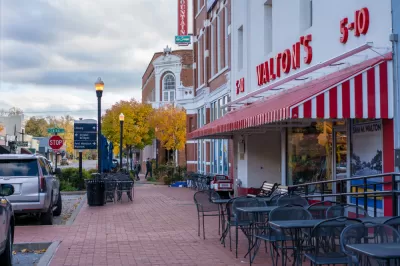Walmart hasn't always synonymous with sprawl, and maybe it won't always be. Its new corporate headquarters has been designed as a walkable urban place, and a magnet for talent.

Patrick Sisson reports in details on plans for Walmart's new corporate headquarters in Bentonville, Arkansas, which attempt to accomplish many of the same kinds of walkable urban design that have become popular with many tech companies on the coasts. Instead of coming to the tech talent in places like the Silicon Valley, Walmart hopes to lure talent to them, in Arkansas.
In May, the company announced plans to build a new campus spread across 350 acres just blocks from Bentonville’s downtown. A vast reimagining of the company’s headquarters, complete with of-the-moment design trends—mass timber construction and bike paths bisecting cafes and outdoor meeting rooms—the planned campus offers a vision of corporate evolution, showcasing the retailer as a high-tech, cutting-edge talent magnet.
Sisson also points out the urban design ethos apparent in the designs, created by Gensler, Sasaki, and SWA.
It’s also a prime example of how corporations use—and, some might say, co-opt—the language of urbanism to present themselves as good neighbors and more attractive places to work. Walmart seeks to build a new neighborhood that will not only be a destination for tech workers, but also a new amenity for everybody in Bentonville.
As noted by Sisson, Walmart's urban design ambitions, as represented by these plans, also represents a return to the company's past as a small town store located on a walkable mainstreet, before it became synonymous with big box stores, sprawl, and massive parking lots.
FULL STORY: Why Walmart is turning its new headquarters into a walkable town square

Planetizen Federal Action Tracker
A weekly monitor of how Trump’s orders and actions are impacting planners and planning in America.

Map: Where Senate Republicans Want to Sell Your Public Lands
For public land advocates, the Senate Republicans’ proposal to sell millions of acres of public land in the West is “the biggest fight of their careers.”

Restaurant Patios Were a Pandemic Win — Why Were They so Hard to Keep?
Social distancing requirements and changes in travel patterns prompted cities to pilot new uses for street and sidewalk space. Then it got complicated.

California Homeless Arrests, Citations Spike After Ruling
An investigation reveals that anti-homeless actions increased up to 500% after Grants Pass v. Johnson — even in cities claiming no policy change.

Albuquerque Route 66 Motels Become Affordable Housing
A $4 million city fund is incentivizing developers to breathe new life into derelict midcentury motels.

DC Area County Eliminates Bus Fares
Montgomery County joins a growing trend of making transit free.
Urban Design for Planners 1: Software Tools
This six-course series explores essential urban design concepts using open source software and equips planners with the tools they need to participate fully in the urban design process.
Planning for Universal Design
Learn the tools for implementing Universal Design in planning regulations.
Heyer Gruel & Associates PA
JM Goldson LLC
Custer County Colorado
City of Camden Redevelopment Agency
City of Astoria
Transportation Research & Education Center (TREC) at Portland State University
Camden Redevelopment Agency
City of Claremont
Municipality of Princeton (NJ)




























